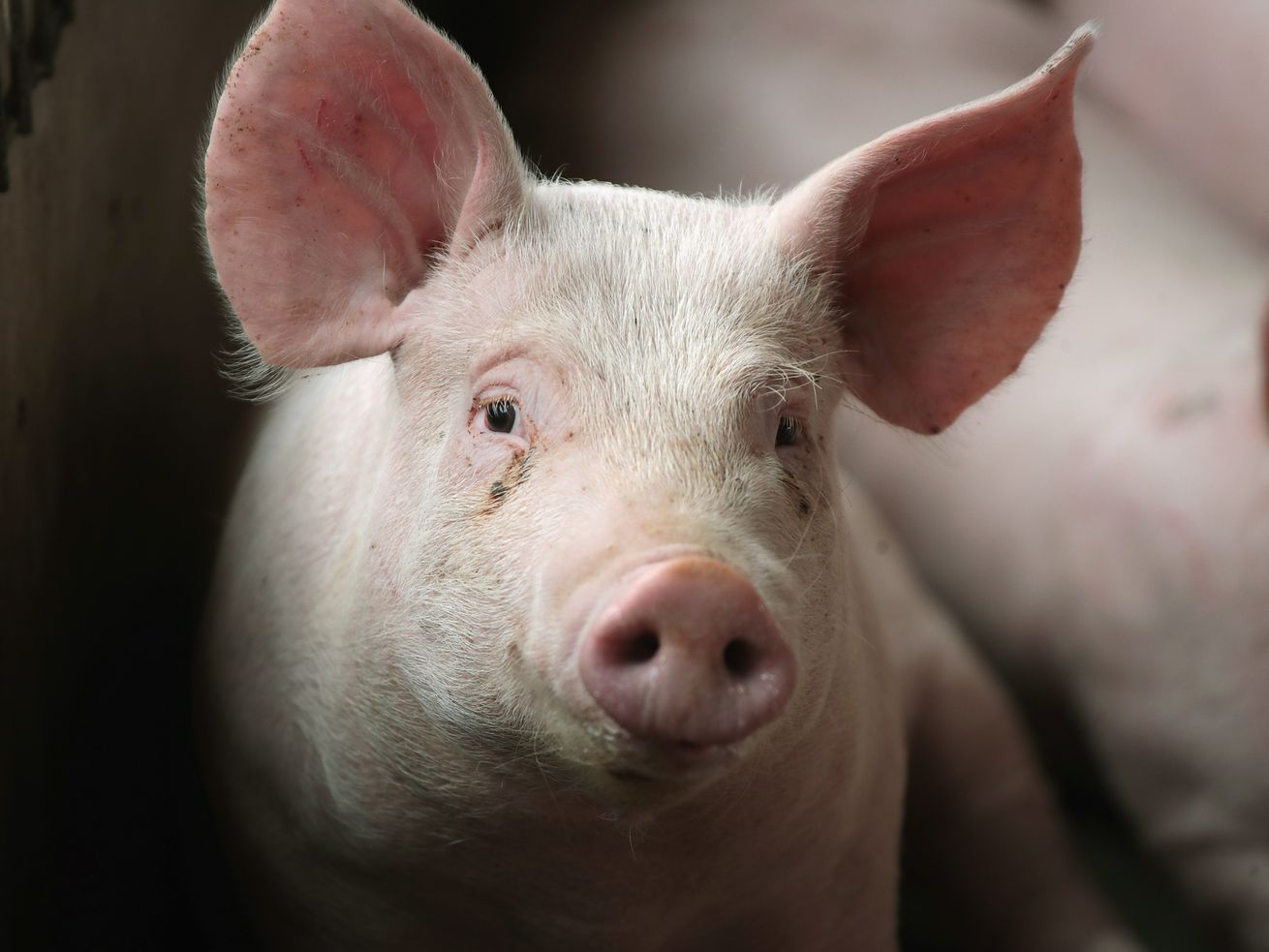An impending California law will get farm animals out of cages. Big Meat is pushing back hard.
In 2018, California voters passed Prop 12, a ballot initiative that is the nation’s — and some say the world’s — strongest law to improve living conditions for farmed animals.
It seems modest on its face: Some of the animals raised for consumption in California must be given additional space. But once fully implemented on January 1, 2022, it will affect nearly a million pigs and 40 million egg-laying hens each year.
Currently in the US, most female breeding pigs — or sows — are confined in gestation crates, metal enclosures so small the pigs can’t turn around for virtually their entire lives, while most egg-laying hens are crammed into battery cages that restrict them from even fully opening their wings for 18 months. Under Prop 12, these practices will be illegal. (A part of Prop 12 that covers veal went into effect at the start of 2020.)
But the impact of Prop 12 won’t be restricted to the Golden State. It will also be felt by pork and egg producers across the country who will have to retrofit existing barns and/or build new ones to comply — a costly and complex transition — if they want to continue to sell to California, which consumes about 15 percent of the nation’s pork and 12 percent of the nation’s eggs and veal.
That’s why the law has been under attack from various meat industry trade groups, which have filed three separate lawsuits to overturn it.
For years, legal challenges loomed as an existential threat to animal protection, with advocates fearing that California’s landmark law was in jeopardy. But in late July, the US Ninth Circuit Court of Appeals ruled against a challenge to Prop 12 from the National Pork Producers Council and the American Farm Bureau Federation.
“It’s a resounding win against the pork industry, which is employing desperate tactics to try to reverse the most critical farm animal law passed in US history,” says Josh Balk, vice president of farm animal protection at the Humane Society of the United States, which led the effort to pass Prop 12. (Disclosure: I worked on cage-free advocacy in my previous career, including at the Humane Society.)
That decision came just weeks after the Supreme Court declined to take up another one of the lawsuits, from the North American Meat Institute.
The industry’s core argument is that Prop 12 violates the “Dormant Commerce Clause,” a legal doctrine meant to prevent protectionism, or states giving their own businesses preferential treatment over businesses in other states. Industry groups argue that because most US pork is produced outside California, the financial and logistical burden of complying with Prop 12 falls mostly on out-of-state producers, and that those burdens outweigh any of the law’s supposed benefits.
But the courts aren’t buying it. In the Ninth Circuit’s decision last month, Judge Sandra S. Ikuta said that even if the industry claims about the burdens of Prop 12 compliance are true, that doesn’t mean it violates the Constitution.
“Even though the Council has plausibly alleged that Proposition 12 will have dramatic upstream effects and require pervasive changes to the pork production industry nationwide, it has not stated a violation of the dormant Commerce Clause under our existing precedent,” Judge Ikuta wrote in the decision.
“The court doesn’t care whether it’s going to be a difficult or costly transition — it cares whether or not Prop 12 is protectionist, and it decided it’s not,” says Kelsey Eberly, a staff attorney with the Animal Legal Defense Fund, a nonprofit that submitted written and oral arguments in defense of Prop 12 on two of the lawsuits.
The National Pork Producers Council disagrees. “We are disappointed in the court’s decision and maintain our position on Prop 12: It is a clear violation of the U.S. Constitution’s Commerce Clause,” Jim Monroe, the organization’s vice president of communications, said in an emailed statement. “We are evaluating the decision and our next steps.”
Meat industry trade groups still have some paths forward, but their options are limited. And the consistent dismissal of their lawsuits not only means that it’s likely Prop 12 will go into effect in January, it also bodes well for similar laws in other states.
To be sure, Prop 12 will not turn industrial farming into a paradise on earth for animals, who will still stuffer all of the inhumane trappings of factory farming, just with some space to move about. Among other torturous practices, hens will still have their beaks seared off without anesthesia; sows will still be confined in farrowing crates — which are similarly restrictive as gestation crates — for a few weeks after each birth as they nurse their piglets. The progress brought about by Prop 12 speaks more to just how terrible conditions have been than how good they might be under new laws.
And progress doesn’t come without a cost. Improving the quality of life of animals in industrial farms will mean changes to the way they’re raised — changes that will invariably involve costs that will be passed down to consumers. The price of bacon and other pork products in California will probably increase on January 1, and there may even be temporary shortages until the industry stabilizes. (Bacon, however, won’t “disappear,” as one recent Associated Press headline warned it might.)
If there is a shortage, much of it will be the pork industry’s making. Compare the pork industry’s response to Prop 12 with another industry’s: Egg producers are largely expected to comply just fine (though some in the industry think the price of eggs could rise too). United Egg Producers, an industry trade association whose members produce nearly all eggs consumed in the US, said in an emailed statement, “UEP’s farmer-members support all types of hen housing and will comply with California’s new law, when implemented.”
Meanwhile, instead of getting to work to comply with the law, the pork industry has spent the past three years suing to overturn it. Now, with two failed court cases and five months until implementation, it’s warning its customers that there isn’t enough time to abide by Prop 12’s requirement.
Whatever happens to the availability and price of pork and eggs on January 1, 2022, the implementation of Prop 12 will be a pivotal moment in the effort to end some of the meat and egg industry’s cruelest practices — one that could shape how farmed animals are raised for decades to come.
Prop 12, explained
Beginning in the early 2000s, the Humane Society of the United States and a handful of other animal welfare groups set their sights on ridding the food system of cages, a nearly universal practice at the time that condemned hundreds of millions of egg-laying hens, millions of breeding pigs, and hundreds of thousands of veal calves to extreme confinement.
An early victory came in 2008, when California voters supported Prop 2, a ballot proposition that imposed a “production” ban on cages, meaning in-state producers had to ensure pigs, hens, and calves could lie down, turn around, and extend their limbs or wings without hitting the side of an enclosure. This language resulted in some egg farms going cage-free, while some continued to use cages but just put fewer hens in each cage or used larger cages (a loophole that frustrated animal welfare activists).
Then in 2010, the California legislature passed AB 1437, a law that upped the ante. It required all eggs sold in the state meet those standards (known as a “sales” ban), and it went into effect in 2015.
These and other measures have been yielding results. Just six years ago, six percent of hens were cage-free. Now, over 30 percent are, and that figure is expected to continually rise every year as Prop 12 and other state laws come into effect, and food companies increase their purchasing of cage-free eggs.
/cdn.vox-cdn.com/uploads/chorus_asset/file/22748762/Vbkxl_the_growing_share_of_cage_free_us_hens_nbsp_.png)
Critically, Prop 12, passed by California voters via ballot measure in 2018, closes some of the remaining gaps in these laws.
It explicitly requires “cage-free” conditions for hens, and also expands how many hens are covered: About two-thirds of all eggs are sold as “shell eggs,” the kind you buy in a carton at the grocery store; the rest are sold as “liquid eggs” for restaurants, cafeterias, and food manufacturers. California’s older animal welfare law only covered shell eggs, but Prop 12 extends the cage-free ban to cover hens produced for liquid eggs as well.
The law should have an even bigger relative impact on the pork industry, which has been more stubborn in eliminating confinement systems.
There are 125 million pigs raised for food in the US each year, a little over six million of them are sows used for breeding, and just one million of those sows are raised for the California marketplace. But for those one million sows, the difference between life in a gestation and crate and life outside of one will be stark. The crates are barely larger than the sows’ bodies — so small that the animals can’t turn around for the duration of their numerous four-month pregnancies.
/cdn.vox-cdn.com/uploads/chorus_asset/file/22764978/GettyImages_1315780786.jpg) MediaNews Group via Getty Images / Harold Hoch
MediaNews Group via Getty Images / Harold HochThe crates take a physical toll — sows can develop sores as well as foot and leg injuries from having to lay on concrete all day, and the immobility reduces their bone strength. The crates take a mental toll, too. Pigs are highly social, curious animals who, in natural settings, are usually quite active. But in intensive confinement systems, they might bite the bars of their crates or repeatedly move their head side to side — signs of distress, boredom, and frustration.
To date, 10 states have banned gestation crates, and around 55 food companies have pledged to eliminate them from their supply chain. But compared to the progress for hens, the results have been mixed.
Some companies, like Chipotle and Whole Foods, have made good on their promises to ban gestation crates from their supply chain. But most have not, according to a report by World Animal Protection, a UK-based international animal welfare organization. And most states that have banned gestation crates don’t raise a lot of pigs to begin with.
Some major pork producers have begun to phase out gestation crates in their supply chain, moving sows to “group housing” pens. These industry shifts have brought the share of crate-free sows from just 10 percent in 2011 to about 28 percent, but with a big catch — most pork producers that use group housing pens still use gestation crates for the 30 to 40 days between the time they finish weaning their piglets and when they’re reimpregnated, what some call “early stage confinement.” This is another critical animal welfare gap that Prop 12 will close.
Prop 12’s space requirements are also stricter than any other law, giving sows 24 square feet apiece, well over the industry’s typical crate-free space allotment of 16 to 18 square feet. This means most pork producers probably aren’t prepared to supply California with compliant pork come January, leading some industry analysts to predict bacon shortages in the New Year.
A looming bacon shortage in California?
In the North American Meat Institute lawsuit against California filed in 2019, employees from the country’s biggest pork companies declared under penalty of perjury that their companies likely wouldn’t be able to meet California’s demand for pork under the new strictures.
A spokesperson for Smithfield, which raises about 15 percent of all US sows, said in a declaration in the lawsuit, “There will be an inadequate supply of Proposition 12-compliant hogs to meet existing demand for fresh whole pork meat in California.” The spokesperson added, “It is no exaggeration to state that the expense and complications of complying with Proposition 12 may cause Smithfield to conclude it is no longer viable to do business in California.” Similar comments were made by representatives from Hormel, JBS, Tyson Foods, and Clemens Food Group in the lawsuit.
Over a year later, according to industry insiders, not much had changed. In March 2021, Christine McCracken, executive director of the animal protein division at agribusiness financial services company Rabobank, published a report in which she predicted a Prop 12 pork shortage. Per the report, California eats about 15 percent of the nation’s pork, but only 4 percent of sows were raised in housing compliant with Prop 12. The National Pork Producers Council says less than 1 percent of US pork meet’s Prop 12 standards.
In a webinar for pork producers about Prop 12 compliance recorded in April 2021, McCracken put it bluntly: “We’re looking at a shortage. If implemented as set, we’re not going to have enough pork to meet the needs of California. The pork that is compliant is clearly going to be priced at a premium.”
McCracken declined to be interviewed for this story, but she’s probably right about a looming shortage. What she didn’t say in that presentation is that this entire scenario was avoidable.
By the time Prop 12 goes into effect, the pork industry will have had more than three years to change housing systems for about a million of its 125 million pigs. Instead, it will have spent much of its time and resources unsuccessfully suing California.
Meanwhile, egg producers — including the largest one in the US, which raises about 12 percent of the nation’s hens — have been rapidly converting cage operations to cage-free.
Compliance will be a lot of work, both the initial project of converting operations, and continually providing compliance documentation. But as the egg producers have shown, compliance is squarely in the realm of the doable.
And these pork producers are some of the largest, most lucrative food businesses to ever exist, some of which enjoyed enormous windfalls in 2020 as consumers panic-bought meat and other groceries. (And some of the meat companies that are warning that letting pigs turn around will result in pricier pork are the same ones accused of conspiring since 2009 to limit pork supply to inflate its price.)
Despite the public warnings of a coming shortage, some in the industry have been working behind the scenes to comply. Hyatt Frobose of Jyga Technologies, a company that produces feeding equipment for pork production and is helping pork companies reconfigure barns to be crate-free, told me via email that he’s “worked with most of the larger meat packer groups to at least draw up plans for Prop 12 compliance and many of them have moved some of their production in the direction of Prop 12 compliance.”
After the Humane Society of the United States filed a shareholder proposal calling on Hormel to disclose that it’d have trouble complying with Prop 12 — a major financial risk — the company had an about face. Hormel now says it will comply with Prop 12, but it’s actually a relatively small operation, tied for 36th place in US pork production. Clemens Foods Group, ranked 11th, told Civil Eats last year that it’s converting some of its operations.
Niman Ranch and Coleman Natural Foods, smaller producers owned by poultry giant Perdue Farms, will both comply. Niman’s standards have always been higher than Prop 12’s, while Coleman has been working with some of its contract farmers to meet Prop 12 requirements. Chris Oliviero, general manager of Niman Ranch, told me that combined, the two companies own about 38,500 sows, which would put Perdue Farms at #26.
Oliviero thinks that ultimately, the bigger producers will fall in line with the law, even if they’re still trying to overturn it. “There still seems to be this belief by some if they push back hard enough that it won’t happen,” he told me. “But I think at a certain point when we reach a place where it’s going to proceed, the energy, time and money will be focused on making it happen as opposed to fighting it.”
One can see how the law’s formal implementation could play out. California pork prices will probably rise in January, with some in the meat industry claiming animal advocates campaigned for and passed a law that’s just too difficult and too expensive to comply with (reminder that voters overwhelmingly supported the measure). The same thing happened in early 2015 when the predecessor to Prop 12 went into effect for eggs. But the egg industry adapted and egg prices stabilized.
More than anything, the fight over Prop 12 shows just how awful farm animal welfare standards are in the US — simply allowing less than 1 percent of US pigs to be able to turn around has become a multi-lawsuit fight waged for years. Such treatment of a dog or cat would be criminal, yet it’s just how business gets done in the pork industry.
The extreme confinement of farmed animals on a mass scale began in post-World War II America, making meat cheaper and more accessible than ever before in human history. But in recent decades, consumers have increasingly come to understand that the cheap meat we expect comes with a steep cost to animals. Prop 12 is a major part of the effort to confront this cost, and marks a step forward in the expansion of our moral circle.
Author: Kenny Torrella
Read More



